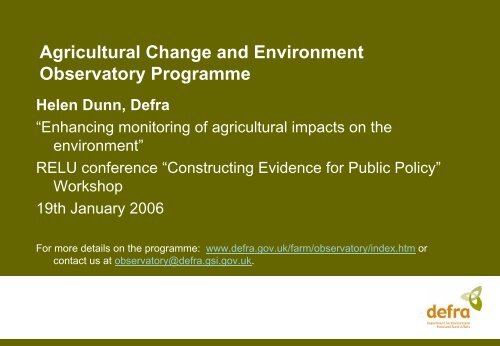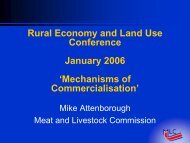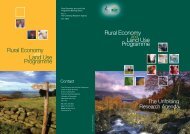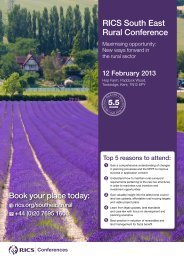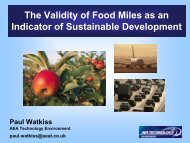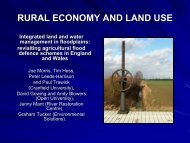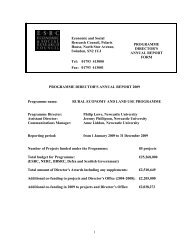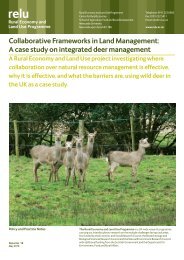Agricultural Change and Environment Observatory Programme
Agricultural Change and Environment Observatory Programme
Agricultural Change and Environment Observatory Programme
You also want an ePaper? Increase the reach of your titles
YUMPU automatically turns print PDFs into web optimized ePapers that Google loves.
<strong>Agricultural</strong> <strong>Change</strong> <strong>and</strong> <strong>Environment</strong><br />
<strong>Observatory</strong> <strong>Programme</strong><br />
Helen Dunn, Defra<br />
“Enhancing monitoring of agricultural impacts on the<br />
environment”<br />
RELU conference “Constructing Evidence for Public Policy”<br />
Workshop<br />
19th January 2006<br />
For more details on the programme: www.defra.gov.uk/farm/observatory/index.htm or<br />
contact us at observatory@defra.gsi.gov.uk.
Outline for presentation<br />
• Background<br />
• Aims of <strong>Observatory</strong> <strong>Programme</strong><br />
• Overview of work programme <strong>and</strong> methods applied<br />
• Links to RELU programme<br />
• Discussion points
Importance of agriculture to the<br />
environment in UK<br />
• Agriculture accounts for only ~0.8% of total economy<br />
in UK<br />
• But agriculture occupies over 70% of total l<strong>and</strong> area<br />
• Crucial role in enhancing biodiversity <strong>and</strong> protection<br />
of natural resources<br />
• Will play important role in helping to meet some of<br />
Defra’s key strategic priorities
Relevant Defra PSA Targets <strong>and</strong> Strategic<br />
Priorities<br />
• PSA 3 – Care for our natural heritage, make the countryside<br />
attractive <strong>and</strong> enjoyable for all <strong>and</strong> preserve biological diversity<br />
by:<br />
• Reversing long term decline in number of farml<strong>and</strong> birds by 2020<br />
• Bringing into favourable condition by 2010 95% of all nationally<br />
important wildlife sites<br />
• Relevant Defra Strategic Priorities:<br />
• Protecting the countryside <strong>and</strong> natural resource protection –<br />
underst<strong>and</strong>ing our impact on the natural environment, managing<br />
our impact on the l<strong>and</strong>, improving water quality, halting the loss of<br />
biodiversity<br />
• Sustainable farming – more customer focused, competitive <strong>and</strong><br />
sustainable farming
Overview of environmental impacts<br />
Estimated Monetary Adjustments to <strong>Agricultural</strong> Accounts (£million 2003, central est)<br />
UK E&W only<br />
1. Water Value of water pollution arising Inl<strong>and</strong> -£71<br />
from agriculture production Coastal -£3<br />
Value of agriculture water abstraction -£36<br />
2. Air Value of air pollution arising from Global -£889<br />
agriculture production Regional -£67<br />
3. Soil Value of (net) soil erosion on farm on n/e n/e<br />
future yields<br />
4. L<strong>and</strong>scape Value of l<strong>and</strong>scape amenity services by +£448<br />
current provision of l<strong>and</strong>scapes<br />
5. Habitats & Value of habitat <strong>and</strong> species protection Habitats +£225 (E)<br />
Species services provided by current l<strong>and</strong>-use Species +£307<br />
6. Waste Value of waste pollution <strong>and</strong> disamenity -£15<br />
arising from agricultural production<br />
Source: Framework for <strong>Environment</strong>al Accounts for Agriculture, EFTEC, July 2004
2003 CAP Reform <strong>Change</strong>s<br />
• Introduction of Single<br />
Payment 2005…..<br />
• …..Payments decoupled<br />
from production<br />
• Farmers much more<br />
exposed to market signals<br />
• In theory, decisions on<br />
whether to produce should<br />
exclude single payment
Wider elements of CAP Reform<br />
• Decoupling <strong>and</strong> single payment<br />
• Dairy reforms<br />
• Cross Compliance<br />
• Set aside<br />
• Modulation<br />
• New Pillar 2 measures – <strong>Environment</strong>al Stewardship<br />
launched in 2005
Past studies on environmental impacts of CAP<br />
Reform<br />
• Key studies by GFA-RACE on potential environmental<br />
impacts of CAP Reform (August <strong>and</strong> December 2003)<br />
• Other studies from JNCC, English Nature<br />
• While environmental impacts expected to be broadly<br />
positive, a mixed picture emerges with significant<br />
uncertainties<br />
• Recognised need for monitoring to pick up early changes
Potential impacts of 2003 CAP Reform on the<br />
environment – previous analysis<br />
Potential positive impacts<br />
• Increase in fallow l<strong>and</strong> <strong>and</strong><br />
reductions in inputs;<br />
• Reductions in emissions to air,<br />
soil erosion, pollution of water<br />
course;<br />
• Reduction grazing pressure on<br />
important habitats<br />
Potential negative impacts<br />
• Decline in mixed farming – less<br />
diversity of l<strong>and</strong>scape <strong>and</strong> habitat<br />
• Reduction in suckler cows –<br />
undergrazing impacts on condition<br />
of SSSIs;<br />
• Specialisation <strong>and</strong> concentration<br />
– localised adverse impacts<br />
• Loss of countryside skills
Aims of <strong>Observatory</strong> <strong>Programme</strong><br />
Overall objective:<br />
“To monitor, <strong>and</strong> where possible anticipate changes in<br />
agriculture <strong>and</strong> at farm level driven by CAP reform, drivers<br />
for that change, <strong>and</strong> consequent implications for the<br />
environment”<br />
To be achieved through collation of information <strong>and</strong> analysis of:<br />
• farmer intentions <strong>and</strong> changes in farming patterns <strong>and</strong> practices;<br />
• links between changes observed at farm level <strong>and</strong> observed<br />
environmental changes, both beneficial <strong>and</strong> detrimental, <strong>and</strong><br />
• future environmental changes on basis of above analysis <strong>and</strong><br />
underst<strong>and</strong>ing of causal links
The <strong>Observatory</strong> – Conceptual Model of what it must do
Overview of Work <strong>Programme</strong><br />
• Work to be undertaken by the internal <strong>Observatory</strong> team<br />
complemented by an external research programme <strong>and</strong> Stakeholder<br />
Advisory Group.<br />
• Key elements of internal team work: data gathering/ analytical role;<br />
developing Defra agricultural statistics to link to environment; making<br />
use of wider economics <strong>and</strong> statistics work in Defra (e.g indicators,<br />
agricultural modelling; FBS); production of Annual Report<br />
• External projects designed to cover both need to maintain updated<br />
picture of the impacts of CAP Reform <strong>and</strong> the environmental<br />
consequences, as well as medium term aims to improve our<br />
underst<strong>and</strong>ing of the changing impact of agriculture on environment.
Internal Research <strong>Programme</strong> 2005-06<br />
• <strong>Environment</strong>al impacts of changes in set-aside <strong>and</strong> fallow in June<br />
Survey 2005<br />
To analyse the changes in set-aside <strong>and</strong> bare fallow following the<br />
introduction of the Single Payment Scheme. See case study.<br />
• <strong>Environment</strong>al impacts of changes in English cattle numbers in June<br />
Survey 2005<br />
To investigate the provisional results of the June Survey that indicated a<br />
reduction in both the dairy herd <strong>and</strong> herd replacements, particularly for the<br />
suckler herd.<br />
• Improved local agricultural data<br />
To develop the methodology for producing agricultural data on a kilometre<br />
square grid using a combination of IACS <strong>and</strong> June Survey/Census data.<br />
Project is being carried out in collaboration with CSL.
External Research <strong>Programme</strong> 2005-06<br />
<strong>Environment</strong>al Monitoring Baseline Project<br />
• To develop a framework for environmental monitoring for the <strong>Observatory</strong> <strong>Programme</strong><br />
<strong>and</strong> using this framework provide a baseline environmental monitoring assessment for<br />
the first year.<br />
<strong>Environment</strong>al impacts of CAP Reform – Assessment of implications of farm level<br />
changes on environmental outcomes<br />
• To provide an updated <strong>and</strong> enhanced assessment of the potential impacts of CAP<br />
Reform on the environment by investigating current <strong>and</strong> predicted trends at the farm<br />
level <strong>and</strong> highlighting the implications for the environment of these changes. The<br />
project will contribute to first year of programme by providing early warning signs of any<br />
changes that could have significant environmental impacts.<br />
Quantitative approaches to assessment of farm level changes <strong>and</strong> implications for<br />
the environment<br />
• To provide a systematic review of the scientific evidence base that the <strong>Observatory</strong><br />
<strong>Programme</strong> can draw on, linking agricultural <strong>and</strong> farm level change to the environment.<br />
It will then undertake a number of case studies in these areas. The project will help in<br />
developing the work of the <strong>Observatory</strong> <strong>Programme</strong> in subsequent years.
Case Study - <strong>Change</strong>s in Set Aside<br />
• Set-aside originally introduced in 1988 as a means of<br />
dealing with over-production<br />
• Whilst the main motivation for set-aside has continued to be<br />
control of cereal production, the scheme has generated<br />
significant environmental benefits:<br />
- reductions in diffuse pollution<br />
- stubble left over winter, providing feeding habitat for<br />
farml<strong>and</strong> birds<br />
- naturally regenerated set-aside provides good<br />
habitat for many birds in breeding season.<br />
- Set-aside strips in arable field margins protect hedges
Case study: <strong>Change</strong>s in set-aside<br />
• Significant changes to set-aside arrangements under SPS<br />
• Temporary grassl<strong>and</strong>, vegetables, sugar beet, etc. now<br />
included in set-aside calculations.<br />
• Project aims to study changes in the areas, spatial<br />
distribution <strong>and</strong> types of set-aside in the first year of the<br />
SPS <strong>and</strong> hence assess likely environmental impacts.<br />
• Using data from 2005 June Survey (Census)<br />
• Also SPS application data (not yet of sufficient quality, but<br />
expecting fresh download within next few days)
Case study: <strong>Change</strong>s in set-aside<br />
2004 2005<br />
Lighter<br />
shading<br />
represents<br />
higher<br />
areas of<br />
set-aside<br />
or fallow
Case study: <strong>Change</strong>s in set-aside<br />
• Using June Survey data for 2004 <strong>and</strong> 2005 we can see<br />
change in national distribution<br />
• Maps show set-aside <strong>and</strong> bare fallow as some l<strong>and</strong><br />
previously recorded as set-aside is now bare fallow,<br />
although no change in management.<br />
• Results are provisional<br />
• Total area up by around 100 thous<strong>and</strong> ha, indicating that<br />
much l<strong>and</strong> withdrawn from production, above 8%<br />
compulsory set-aside.
Methods to be applied for <strong>Observatory</strong><br />
<strong>Programme</strong><br />
• Use of multi disciplinary teams<br />
• Focus on more integrated approach to underst<strong>and</strong>ing<br />
impacts of CAP reform on the environment<br />
• Use of GIS data <strong>and</strong> tools<br />
• Greater use <strong>and</strong> development of Defra agricultural<br />
statistics to link to environment
Links to RELU programme<br />
• Significant common areas of interest in underst<strong>and</strong>ing<br />
agriculture’s impact on the environment <strong>and</strong> implications<br />
of CAP reform<br />
• <strong>Observatory</strong> aims to make use of wide range of data <strong>and</strong><br />
analysis <strong>and</strong> where possible enhance monitoring data<br />
• <strong>Observatory</strong> to be “user” of results of relevant RELU<br />
projects<br />
• Scope for <strong>Observatory</strong> to help out on specific data queries<br />
relevant to agriculture <strong>and</strong> the environment<br />
• Potential for interaction/dialogue as projects proceed
What will be value added of <strong>Observatory</strong><br />
<strong>Programme</strong><br />
• Sustained monitoring of impacts of CAP reform on<br />
environment<br />
• Aims to draw together wide range of information <strong>and</strong><br />
research to present ‘real world’ view<br />
• Keeps focus on identifying early impacts of farm change<br />
on environment;<br />
• Works towards improved evidence base
Challenges for <strong>Observatory</strong> <strong>Programme</strong><br />
• Development of framework for providing early warning<br />
signs of negative environmental impacts<br />
• Numerous policy <strong>and</strong> market drivers – 2003 CAP Reforms<br />
one part of overall picture<br />
• Improving coordination of <strong>Observatory</strong> <strong>Programme</strong> with<br />
programmes addressing the social <strong>and</strong> economic impacts<br />
of CAP Reform


